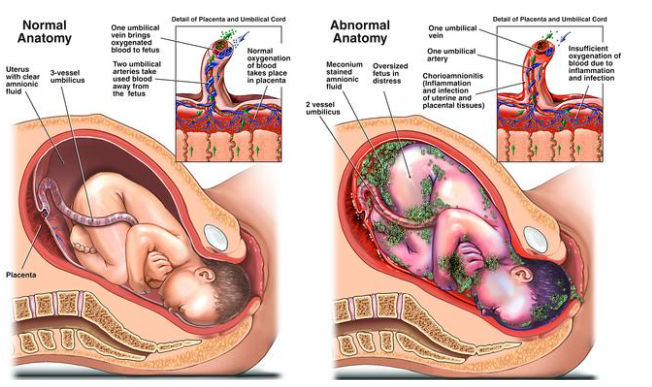A nurse is caring for a client who had an unscheduled cesarean delivery due to fetal distress.
Which of the following interventions should the nurse implement in the immediate postoperative period?
Assess the client’s fundus for firmness and position
Encourage early ambulation to prevent thromboembolism
Monitor the client’s intake and output
All of the above.
The Correct Answer is A
The correct answer is choice D. All of the above interventions should be implemented in the immediate postoperative period after a cesarean delivery.
Choice A is correct because assessing the client’s fundus for firmness and position is important to prevent postpartum hemorrhage and monitor uterine involution. The fundus should be firm and at the level of the umbilicus one hour after delivery and descend into the pelvis at a rate of approximately 1 cm per day.
Choice B is correct because encouraging early ambulation can prevent thromboembolism, which is a potential complication of cesarean delivery. Early mobilization can also reduce pain, ileus, and urinary retention.
Choice C is correct because monitoring the client’s intake and output can help detect fluid imbalance, dehydration, or urinary tract infection.
Fluid intake should be adequate to maintain hydration and support lactation. Urinary output should be at least 30 mL per hour.
Therefore, choice D is correct because all of the above interventions are appropriate for postoperative care after a cesarean delivery.

Nursing Test Bank
Naxlex Comprehensive Predictor Exams
Related Questions
Correct Answer is C
Explanation
The correct answer is choice C) Encouraging coughing and deep breathing exercises.
This is because coughing and deep breathing exercises can help prevent atelectasis and pneumonia, which are common postoperative complications of C-section.
Coughing and deep breathing exercises also promote oxygenation and circulation.
Choice A) Administering an opioid analgesic is wrong because opioids can cause respiratory depression and sedation, which are not desirable before surgery.
Opioids can also cross the placenta and affect the fetus.
Choice B) Assessing for signs of deep vein thrombosis is wrong because this is not a priority intervention before surgery.
Deep vein thrombosis is more likely to occur after surgery due to immobility and venous stasis.
Choice D) Providing a high-carbohydrate meal is wrong because this can increase the risk of aspiration during surgery.
The client should be kept NPO (nothing by mouth) for at least 6 hours before surgery.
Correct Answer is ["A","B","C","D"]
Explanation
The correct answer is choices A, B, C and D. The type of anesthesia used, the estimated blood loss during surgery, the vital signs and oxygen saturation, and the allergies and medications given are all important information to be included in the hand-off report from the anesthesia provider to the recovery area staff.
These information help to assess the patient’s condition, monitor for complications, and plan for appropriate interventions.
Choice E is wrong because the Apgar scores of the newborn are not relevant to the patient’s recovery from cesarean delivery.
The Apgar scores are used to evaluate the newborn’s physical condition at birth and are usually reported by the neonatal team.
The recovery area staff should focus on the patient’s postoperative care and pain management.
Whether you are a student looking to ace your exams or a practicing nurse seeking to enhance your expertise , our nursing education contents will empower you with the confidence and competence to make a difference in the lives of patients and become a respected leader in the healthcare field.
Visit Naxlex, invest in your future and unlock endless possibilities with our unparalleled nursing education contents today
Report Wrong Answer on the Current Question
Do you disagree with the answer? If yes, what is your expected answer? Explain.
Kindly be descriptive with the issue you are facing.
